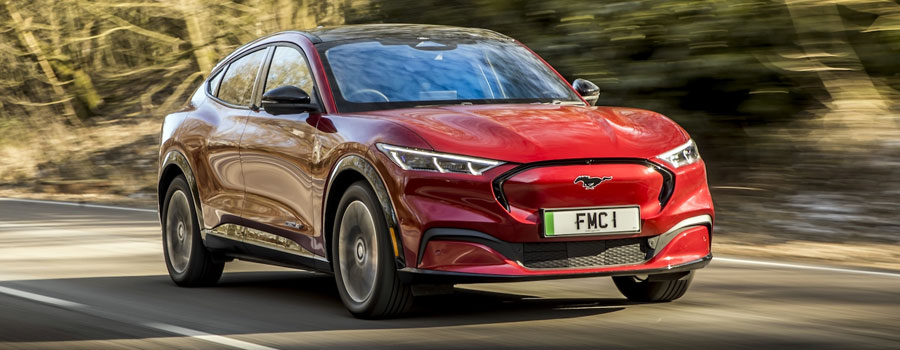Powering the way to better EVs: tracking battery development

A key component of electric cars are the batteries that power them. With the electric car industry still relatively short-lived, we have had only around 10 years of development in battery packs. But what a 10 years it has been.
We look at what's being used, its strengths and weaknesses, and what's coming along to make EVs even better in future.
Starting to change
For more than a decade, the standard EV battery has been lithium-ion, which is found in rechargeable devices around the world - from cars to mobile phones.
It's a reliable and stable battery type, which degrades gradually over time and recharges quickly. But there are other battery types available, and the next few years will see them start to appear.

In fact, Ford has just announced that its Mustang Mach-E will get a new battery. Lithium-iron phosphate (LFP) batteries will be fitted to the Ford Mustang Mach-E later this year, which promise benefits for certain user types. Ford is looking to offer multiple battery types to customers.
Benefits of LFP battery packs include additional durability over lithium-ion batteries, as well as greater tolerance to frequent and faster charging. They also use fewer high-demand, high-cost materials.
It means that smaller batteries could be made, at lower cost, for drivers able to charge frequently and not looking for ultra long driving range.
Economies of scale mean that by Ford committing to LFP batteries, they will be featured in models as varied as the Mustang Mach-E, e-Transit, and F150 Lightning this year and next.
Is it the end for lithium-ion?
Definitely not. Lithium-ion batteries are already made in huge numbers, which means that economies of scale have driven prices down consistently over the years.
As a battery is the largest and most expensive single component of an electric car, it's important to reduce costs to bring EVs in line with the costs of internal combustion engine cars.
Thankfully, we're not far off price parity when comparing electric and engine-powered vehicles, which is down to significant developments over the past few years.
Many manufacturers have managed to pack in greater battery capacity (and therefore driving range) into the same physical space for models that have been around for more than a single generation.
The likes of Tesla, Nissan, Renault, and BMW have worked on battery chemistry, improving the amount of electricity they can store by more than 50% in some cases over the initial packs fitted to early EVs.
That's without compromising reliability, or making the battery physically larger, which takes up more space.
Recharging is also continuing to improve, with shorter recharging times thanks to higher recharging capabilities. The original Nissan Leaf had a 24 kWh battery for a range of around 80 miles, and took half an hour to recharge to 80% on a rapid unit.
The current Nissan Leaf has a battery only a little larger than the original 24 kWh pack, but is rated at 59 kWh, and still takes around half an hour to recharge at the highest rate.
And the Nissan isn't a particularly advanced EV now. Kia's EV6 for example has a newer architecture that allows for even faster charging. With a 74 kWh pack, it covers up to 328 miles on a charge, and can top-up in just 18 minutes.
What's on the horizon?
Although the lithium-ion battery is safe, reliable, and available in large numbers, there are still efforts to introduce new technologies to improve electric car range and charging times.
Ford's LFP batteries are one step, but more of a sideways approach, offering slightly different characteristics over lithium-ion packs.
The “next big thing” is likely to be solid-state batteries. Although these have been promised for a while, the complexity of development for mass-production has meant that solid-state batteries are yet to appear in anything close to a full-production model.
Lithium-ion, LFP… essentially all EV batteries used are chemical batteries. This means that a liquid electrolyte is used, and both anodes and cathodes will decay over time and use. It also places restrictions on charging times and needs cooling systems to ensure they are at the optimum temperature for charging and discharging.
Solid-state batteries, as the name suggests, use a solid electrolyte to allow the charged ions to pass through it. They work in the same way as lithium-ion batteries, but use different materials.
This means that battery capacity is improved, they're even safer, and they can be charged faster. Because of the smaller electrolyte, batteries can be made smaller without compromising on power. Energy density is also between two and 10 times better than a comparable lithium-ion pack, plus they don't need the same cooling requirements.
They are currently used in small applications, such as pacemakers and RFID tags. So expanding operations up to the size of a car's battery while keeping things financially viable is going to be tricky. That, and the materials required to allow a solid-state battery to power a large electric motor. As such, don't expect them to be available in the next generation of EVs… and possibly the next.
Until then, regular development of existing lithium-ion batteries, as well as slightly different chemical compounds based around a theme, means we will continue to see EVs get longer ranges, charge faster, and take up less space… just incrementally so.
View our latest blog posts

Categories
Pages
We are a family run business based in rural Worcestershire. Our team of 38 staff are on hand to provide an exceptional service to personal and business customers.
Read More
